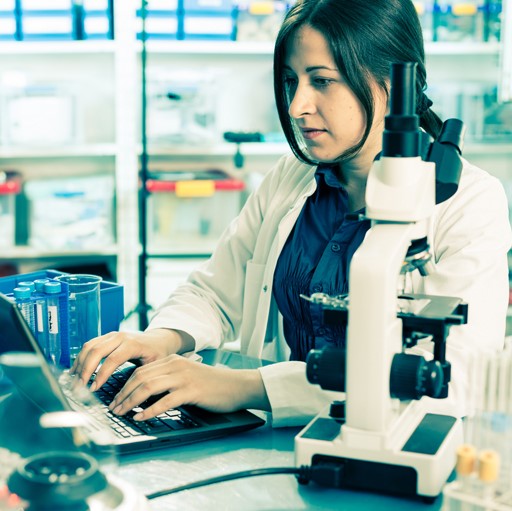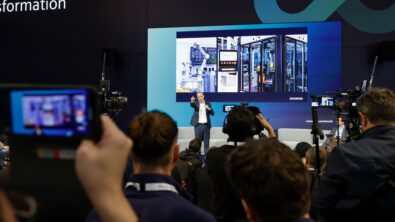Food and Beverage R&D Enters the Digital Age

Digitalization Overview
My prior post, Surviving the New Competitive Landscape in Food and Beverage, explains that consumer goods companies need to leverage digitalization to compete in today’s rapidly evolving, omnichannel markets. Food and beverage companies need to step up to compete with small, innovative companies that are challenging the status quo and taking market share by embracing the digital enterprise.

What do companies need to do to survive? First, they must rapidly identify and react to changes in market and consumer needs. They have to confidently develop innovative new products and deploy them across their global manufacturing network and supply chain with unprecedented speed and quality. But innovation alone isn’t enough in tight markets; they have to drive productivity throughout their operations all the way from product concept to the shelf. Finally, they need to leverage knowledge as a competitive weapon by harnessing data to gain real insights to get a competitive edge in the market.
We’ve identified three primary initiatives companies can pursue to take advantage of the digital enterprise opportunity:
- R&D Enters the Digital Age
- Producing Food and Beverage in the Digital Age
- The Analytics Opportunity for Food and Beverage in the Digital Age
Each of these provides significant business value and serves as a step to implementing an integrated digital thread to become a digital enterprise. This post focuses on the key role that R&D must play to make the transformation to a digital innovation process. Effective R&D is critical to the success of any consumer-oriented business, and digitalizing R&D provides significant value either as a separate initiative or in combination with manufacturing and analytics improvements. Let’s take a look!
Digitalization in R&D
What does “digital” R&D look like? Digitalized R&D is fast and responsive in developing quality products that deliver on consumer needs. Speed comes from enabling innovators and removing obstacles from their paths. For example, food scientists can develop winning products by easily reusing an existing digital model. They can readily collaborate with others and tap into the vast knowledge inside their company and their supplier network. They can focus on innovation knowing that compliance is being checked along the way. Formulators and food scientists in a digital environment have raw material libraries and regulatory data at their fingertips. They’re guided to develop products that comply with requirements as they innovate – not by receiving an email highlighting a problem when they’re preparing for a market launch!
Of course formulators don’t work in a vacuum. Digital R&D is also integrated. Their information is kept in a digital product model, not in documents and spreadsheets. These models can be used to simulate and optimize products and packaging. These models, what some call a “digital twin,” can readily be shared with others in real-time. This allows people like labeling and artwork designers to pull the information they need when they need it, instead of waiting until the last minute or using outdated data. Then, last minute changes are easily identified and incorporated based on an integrated view of the product.
Even more importantly, downstream innovators can directly add to the digital product model to create a cohesive view of the product. For example, packaging specs are added to the model alongside ingredients as an integral part of the product definition. Similarly, process instructions can be created in R&D and flow down to the plant to transform the general recipe into a site-specific one. This helps manage the relationships between different aspects of the product and creates digital continuity of information as it flows to downstream systems and intelligent equipment in the plant.
The R&D Transformation
 R&D needs to make important changes to support the digital enterprise. Many companies have made strides in this area, for example transitioning from paper to electronic documents. They may have electronic lab notebooks (ELN), but typically also have a host of spreadsheets and scanned documents. More problematic, perhaps, is that many companies still have document-centric processes developed from the paper era.
R&D needs to make important changes to support the digital enterprise. Many companies have made strides in this area, for example transitioning from paper to electronic documents. They may have electronic lab notebooks (ELN), but typically also have a host of spreadsheets and scanned documents. More problematic, perhaps, is that many companies still have document-centric processes developed from the paper era.
It’s time to make the leap from electronic to digital. The key element of the digital approach is the cohesive product data model. This model is based on data, not documents. It should align requirements, claims, formulations, packaging, labels, production steps, and quality procedures in a cohesive data model. In addition to data, digital R&D should adopt connected, streamlined processes to take innovation seamlessly from one design step to the next. Then, innovators at each step contribute additional information to create a cohesive model and digital thread.
Digitalizing R&D provides speed and agility to stay ahead of the competition and meet challenging launch dates. At the same time, it helps reduce cost, increase productivity, ensure compliance, and reduce risk. Let’s look at some examples of the results of the transformation.
Focus: The Digital Formulator
Let’s take a closer look at development in the digital food and beverage company. A digital formulator can leverage a workbench approach that puts the right information and tools at their fingertips. To develop a formula, they can start from an existing formula or bring raw materials into a digital model from a library. Detailed ingredient information can easily be used for calculations to quickly determine the impact of decisions like a substitution.
Digital analysis helps innovators compare options and optimize competing targets like cost, stability, certifications, warnings, and desired nutritional claims. At the same time, automated checks can identify regulatory or claims issues early, letting formulators focus on product performance. Beyond simple calculations, digitalized R&D can leverage chemical simulation to innovate more rapidly and reduce the need for manual bench testing.
Digital formulators rely on digital data. R&D models are cohesive, as each process steps adds information that builds and enriches the digital model. For example, target requirements and claims used as input can be linked to the resulting recipe. Then, scientists can include tests and test results to document proof of performance. They can use this information to seamlessly submit and track approvals, and then leverage that information to develop product dossiers and documentation without manual collection and recreation of data. Linked information can also provide a mechanism to quickly identify the impact of change and apply updated information to downstream deliverables.
Focus: Connected Product Developers
R&D needs more than information, they need input from others across design disciplines. Traditionally, developing food and beverage products involves periodic data sharing. This creates a waiting game. Packaging waits for final requirements. Artwork waits for claims and nutritional data. Packaging and label design waits for print-ready artwork. Digitalization provides the opportunity for formulators, packaging engineers, and artists to share and update this information as it’s developed. It allows for seamless interaction along a digital thread connecting all of these aspects.
Digitalization also opens up new opportunities for collaboration. For example, it makes it practical to share work-in-process formulas with process and manufacturing engineers to get feedback on production feasibility and cost. The plant can leverage the digital product model to simulate production processes on digital models, also known as “digital twins,” of the plant to start optimizing productivity while the window of opportunity for change is still open.
Another consideration is that the digital enterprise keeps R&D and NPDI information together in one place, creating a cohesive view of products and projects. In this way, they can ensure product launches are synchronized between product development, formulation, packaging, quality, the supply chain, and others. Developing and maintaining this connection around a cohesive product model allows companies to adapt and introduce changes with confidence, knowing they can be validated and communicated clearly to the supply chain and the plant without disrupting production or quality.
Focus: Prepping for Production
 Developing the digital model is not the end of the journey. A digital model that simply ends up in an R&D repository only provides partial value. Instead, digitalization allows the digital thread to continue on. As mentioned earlier, the digital model can be used as the basis for developing and optimizing production processes. This information can be used to create general recipes that provide the information the plants need to produce the product. Instead of recreating the wheel, production planning can digitally deploy and commission controls and plant equipment across the globe. This allows companies to quickly scale up to production volume based on the latest data, and easily apply changes to the plant as needed.
Developing the digital model is not the end of the journey. A digital model that simply ends up in an R&D repository only provides partial value. Instead, digitalization allows the digital thread to continue on. As mentioned earlier, the digital model can be used as the basis for developing and optimizing production processes. This information can be used to create general recipes that provide the information the plants need to produce the product. Instead of recreating the wheel, production planning can digitally deploy and commission controls and plant equipment across the globe. This allows companies to quickly scale up to production volume based on the latest data, and easily apply changes to the plant as needed.
Focus: Learning from Operational Results
This post isn’t intended to cover digitalizing production, but it’s important to recognize the opportunity to close the loop from production back to R&D. Digital batch records add real-world results to the digital thread, creating a wealth of data to access and learn from. Data from plant controls, smart equipment, and the Internet of Things (IoT) provides a window into substitutions, changing manufacturing parameters, and other realities of the plant that are frequently beyond the view of product developers.
Although we’ll go into more detail into analytics in a future post, it’s important to recognize the value to R&D. They can use big data analytics to look at combinations of data that include operational information such as ingredients, lines, equipment, and environmental data to see where plants are deviating from specs and how that impacts results. This can help identify issues such as whether the plant is making substitutions or producing in proximity of allergens. That information can be critical to either improve processes or trigger a change to the label. With this type of information, companies can look for potential issues and opportunities to investigate to see if manufacturing processes need to be adjusted or enforced.
For more advanced companies, this information can provide data for problem solving and root cause analysis, helping them gain new insights. It can also open up the opportunity to use simulation technologies to better predict product characteristics without the need for bench testing, or to predict stability without having to wait for results. These companies can leverage digital information to develop a virtual product, test it out, simulate it, and optimize it – all in a digital world. Digitalization is the key to opening up the opportunity for these kinds of initiatives.
Enabling Digitalization in R&D
Digitalization requires the right supporting technology. Today’s patchwork of solutions and document-centric processes simply can’t support the automation, integration, and analytics described above. Digitalization requires a platform approach to supporting product innovation, product development, and production.
Specifically, digitalization requires a cohesive, integrated product model, not silos of information. It demands integrated processes in order to improve the efficiency of R&D, promote reuse of knowledge, allow designers across disciplines to synchronize their work, and provide the right data to commission manufacturing systems and smart equipment. Finally, it benefits from a cohesive body of knowledge for reuse and deeper insights to drive operational improvement.
The Digitalization Payoff in R&D
As the Surviving the New Competitive Landscape in Food and Beverage post concludes, “Digitalization increases the velocity at which Food and Beverage companies innovate and get to market. It allows them to be agile and respond to changes without introducing costly errors.” Digitalizing R&D is a significant step forward toward achieving that value as a standalone initiative or as a part of a broader digital enterprise transformation. The status quo is no longer enough and it’s time for R&D to respond. What will your company do to survive the market disruption?
Jim Brown is the President of Tech-Clarity, an independent research firm focused on how manufacturers use best practice processes and software to drive operational improvement and business value. www.tech-clarity.com


